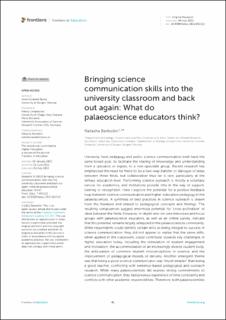| dc.description.abstract | University-level pedagogy and public science communication both have the same broad goal: to facilitate the sharing of knowledge and understanding from a specialist or expert, to a non-specialist group. Recent research has emphasised the need for there to be a two-way transfer or dialogue of ideas between these fields, but collaboration thus far is rare, particularly at the tertiary education level. Performing science outreach is mostly a voluntary service for academics, and institutions provide little in the way of support, training or recognition. Here I explore the potential for a positive feedback loop between science communication and higher-education pedagogy in the palaeosciences. A synthesis of best practises in science outreach is drawn from the literature and related to pedagogical concepts and findings. The resulting congruences suggest enormous potential for ‘cross-pollination' of ideas between the fields. However, in-depth one-on-one interviews and focus groups with palaeoscience educators, as well as an online survey, indicate that this potential remains largely untapped in the palaeosciences community. While respondents could identify certain skills as being integral to success in science communication, they did not appear to realise that the same skills, when applied in the classroom, could contribute towards key challenges in higher education today, including the stimulation of student engagement and motivation, the accommodation of an increasingly diverse student body, the anticipation of common student misconceptions in science, and the improvement of pedagogical models of delivery. Another emergent theme was that being a good science communicator was “much simpler” than being a good teacher, conflicting with evidence-based pedagogical and outreach research. While many palaeoscientists did express strong commitments to science communication, they had previous experience of time constraints and conflicts with other academic responsibilities. Therefore, both palaeoscientists and their institutions would benefit from viewing science communication as a valuable and formally rewardable activity within the scholarship of sharing knowledge, which also contributes to other aspects of a successful academic career. | en_US |

